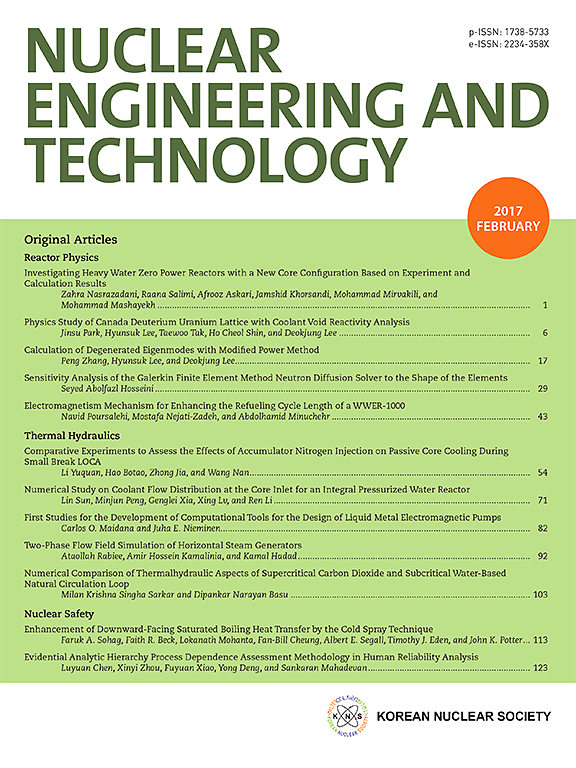Utilization of reverse osmosis and nanofiltration for the separation of SiO2 from boric acid solutions at nuclear power plants
IF 2.6
3区 工程技术
Q1 NUCLEAR SCIENCE & TECHNOLOGY
引用次数: 0
Abstract
Even though the problem with an increasing SiO2 concentration in the reactor cooling system (RCS) emerges at most nuclear power plants, no publications yet have focused on the separation of SiO2 from solutions simulating RCS composition regarding boric acid (16 g/L) and silica concentrations (0–12 mg/L). Therefore, we examined the utilization of reverse osmosis and nanofiltration to separate SiO2 from H3BO3 solutions simulating RCS composition to meet the operation limits of SiO2 and to minimize additional costs for H3BO3 refill. The rejection of both H3BO3 and SiO2 by reverse osmosis was generally high (>90%). The maximal separation efficiency of SiO2 from H3BO3 was achieved at low pH and high temperature and was 1.30. The rejection of H3BO3 by nanofiltration was around 20% and of SiO2 around 80%. The highest separation efficiency was achieved at low pH and intermediate SiO2 concentrations and was 2.23. To achieve the operation limits for SiO2, a multi-stage nanofiltration system must be used for the solutions with intermediate and high SiO2 concentrations. Nanofiltration is for the separation of SiO2 from H3BO3 solutions more favorable than reverse osmosis, because of the higher separation efficiency of SiO2 from H3BO3, and thus, lower H3BO3 loss.
求助全文
约1分钟内获得全文
求助全文
来源期刊

Nuclear Engineering and Technology
工程技术-核科学技术
CiteScore
4.80
自引率
7.40%
发文量
431
审稿时长
3.5 months
期刊介绍:
Nuclear Engineering and Technology (NET), an international journal of the Korean Nuclear Society (KNS), publishes peer-reviewed papers on original research, ideas and developments in all areas of the field of nuclear science and technology. NET bimonthly publishes original articles, reviews, and technical notes. The journal is listed in the Science Citation Index Expanded (SCIE) of Thomson Reuters.
NET covers all fields for peaceful utilization of nuclear energy and radiation as follows:
1) Reactor Physics
2) Thermal Hydraulics
3) Nuclear Safety
4) Nuclear I&C
5) Nuclear Physics, Fusion, and Laser Technology
6) Nuclear Fuel Cycle and Radioactive Waste Management
7) Nuclear Fuel and Reactor Materials
8) Radiation Application
9) Radiation Protection
10) Nuclear Structural Analysis and Plant Management & Maintenance
11) Nuclear Policy, Economics, and Human Resource Development
 求助内容:
求助内容: 应助结果提醒方式:
应助结果提醒方式:


